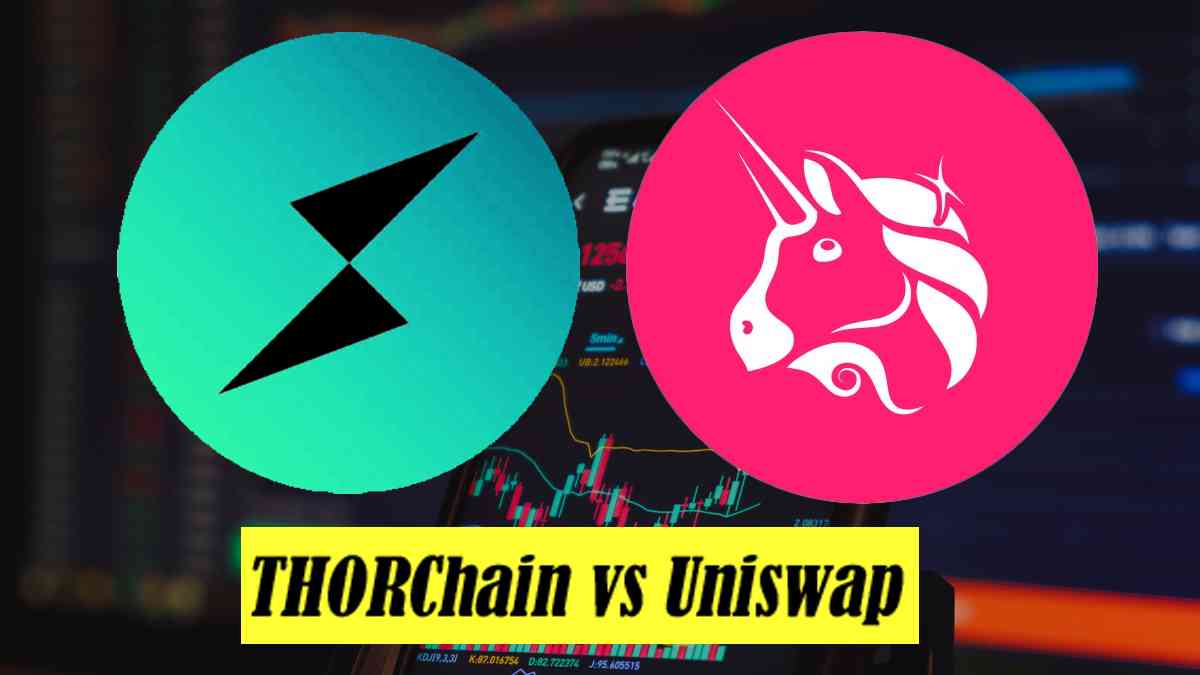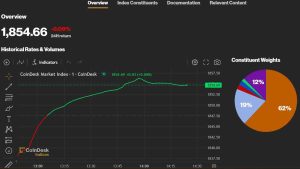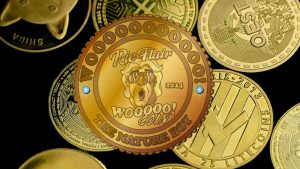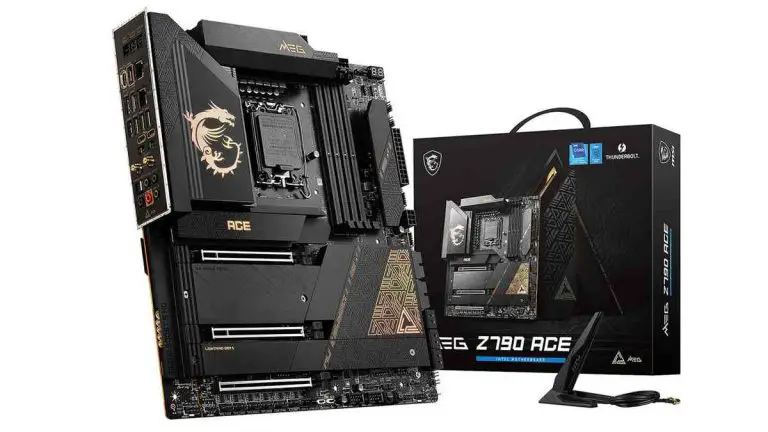Cryptocurrency enthusiasts and traders, buckle up! In this guide, we’re diving deep into decentralized finance (DeFi), focusing on two prominent players: THORChain and Uniswap. These platforms facilitate seamless cryptocurrency swaps with unique features, advantages, and user experiences. Whether you’re a seasoned trader or a crypto novice, understanding the nuances of THORChain and Uniswap can empower you to make informed decisions aligning with your investment goals.
Unveiling THORChain vs Uniswap
What is THORChain?
THORChain stands as a decentralized liquidity network facilitating cross-chain swaps between various cryptocurrencies. Imagine trading assets across different blockchains directly from your thorchain wallet – that’s the power THORChain provides. The native cryptocurrency, RUNE, fuels these thorchain swaps.
How THORChain Works
THORChain’s magic lies in its liquidity pools. Users deposit assets into these decentralized pools, ensuring liquidity for trading. When a trade is initiated, THORChain matches it with available liquidity in the pool, executing the swap instantly. What’s unique? THORChain supports cross-chain transactions, enabling you to swap assets from one blockchain to another without intermediaries.
Benefits of Using THORChain
1. Decentralization: Enhanced security, reduced risk of hacks – THORChain’s decentralized protocol eliminates intermediaries.
2. Cross-chain compatibility: Swap assets across different blockchain networks, opening up new possibilities.
3. Non-custodial: Retain control over your funds – transactions occur directly between wallets.
4. Instant swaps: Liquidity pools ensure immediate execution of trades, providing a seamless trading experience.
| Feature | Description |
| Type | Decentralized Liquidity Network |
| Function | Facilitates cross-chain token swaps without centralized intermediaries |
| Supported chains | Bitcoin, Ethereum, BNB Chain, Cosmos Hub, Avalanche, and others (continuously expanding) |
| Asset type | Native assets (no need for wrapped or pegged versions) |
| Key benefits | – Non-custodial swaps: users maintain control over their funds throughout the process – Reduced fees: competitive rates, especially for large swaps (streaming swaps) – Increased security: permissionless, censorship-resistant network |
| Token | RUNE (used for liquidity provision, governance, and fees) |
| Current price (as of Dec 17, 2023 6:02 PM IST) | $5.66 |
| Website | https://thorchain.org/ |
| https://twitter.com/thorchain_org?lang=en |
What is Uniswap?
Uniswap, on the other hand, is a decentralized exchange (DEX) built on the Ethereum blockchain. Its unique automated market maker (AMM) model relies on liquidity pools and smart contracts for trading, gaining popularity for its user-friendly interface within the DeFi space.
How Uniswap Works
Uniswap operates with liquidity pools instead of traditional order books. Liquidity providers deposit assets into these pools, facilitating trades. When initiating a trade, a user interacts with a smart contract that calculates prices based on available liquidity.
Foundational Differences
Liquidity Pools: The Heart of the Operation
THORChain and Uniswap approach liquidity pools differently. THORChain embraces a decentralized cross-chain liquidity protocol, allowing direct trading across blockchains. In contrast, Uniswap focuses on providing liquidity for ERC-20 tokens within the Ethereum ecosystem.
Cross-Chain Functionality vs. Ethereum-Centric Approach
While both platforms offer decentralized trading, THORChain’s standout feature is cross-chain functionality. Swap assets from one blockchain to another seamlessly. Uniswap, in contrast, confines its operations within the Ethereum network.
Native Tokens: RUNE vs. UNI
THORChain boasts its native token, RUNE, which is pivotal for network security and governance. Holders of RUNE participate in staking and have voting rights. Uniswap introduced UNI as its governance token, incentivizing liquidity providers and participants.
Impermanent Loss Mitigation: Slashing Mechanism vs. Fee Structure
Both platforms address impermanent loss differently. THORChain uses a slashing mechanism, penalizing nodes for malicious behavior. Uniswap tackles it through trading fees compensating liquidity providers.
Network Security: Consensus Algorithms and Audits
THORChain employs a Byzantine Fault Tolerant (BFT) consensus algorithm, ensuring transaction security. Regular audits enhance network security. Uniswap operates on Ethereum’s Proof-of-Stake (PoS) algorithm, transitioning to Ethereum 2.0 for scalability and security.
Scalability: Native Cross-Chain Swaps vs. Layer 2 Solutions
THORChain’s cross-chain functionality allows native swaps across blockchains, ensuring scalability without layer two solutions. Uniswap, on Ethereum, faces scalability challenges, with Ethereum 2.0 aiming to address them.
User Experience: Simplicity vs. Advanced Features
Uniswap offers a user-friendly interface for beginners and experienced traders, focusing on easy decentralized trading within Ethereum.
Supported Platforms
THORChain and Uniswap operate on different blockchain networks. THORChain on its network, Uniswap on Ethereum. Each has its own set of supported tokens. THORChain supports a wide range, including Bitcoin and Ethereum. Uniswap primarily supports ERC-20 tokens native to Ethereum.
Audience Reach
THORChain’s cross-chain support broadens its reach, attracting users from diverse blockchain ecosystems. Uniswap, which is Ethereum-based, caters primarily to the Ethereum community. Both platforms offer intuitive interfaces, making decentralized trading accessible.
Analyzing Trading Volume and Native Coins
Trading Volume
THORChain and Uniswap boast substantial trading volumes. THORChain’s unique design facilitates interoperability, attracting users steadily. Uniswap, as a leading Ethereum DEX, benefits from Ethereum’s dominance in DeFi, resulting in higher trading volumes.
Native Coins
RUNE and UNI play crucial roles. RUNE facilitates transactions and secures THORChain with staking mechanisms and governance. UNI grants governance rights and fee earnings on Uniswap, which are distributed among liquidity providers.
Fees
THORChain’s validators charge fees, generally lower than traditional exchanges. Uniswap charges a fixed 0.3% fee per trade. Traders should consider fee structures for overall costs.
Speed
THORChain’s cross-chain capabilities lead to quick and efficient swaps. Uniswap, on Ethereum, may experience congestion, affecting transaction speeds. Ethereum 2.0 plans to improve scalability.
Ecosystem Support and API Accessibility
Ecosystem Support
THORChain’s cross-chain compatibility attracts developers. Uniswap, a leading Ethereum DEX, has a user-friendly interface but operates within Ethereum’s network.
API Accessibility
Both platforms offer APIs for developers. THORChain provides comprehensive documentation for smooth integration. Uniswap’s less extensive API facilitates interaction with liquidity pools and trades.
Reviews, Ratings, and Community Trust
Positive Reviews and High Ratings
Users praise THORChain for its security and seamless cross-chain experience. Uniswap gains acclaim for simplicity and efficiency, contributing to high ratings.
Community Trust and Engagement
Both platforms foster vibrant communities. THORChain’s community actively participates in development discussions. Uniswap’s community contributes to growth through liquidity provision and development.
Reviews from Industry Experts
Experts laud THORChain’s cross-chain innovation and Uniswap’s impact on DeFi. Both platforms prioritize security through audits and measures.
Trustworthiness and Security
THORChain and Uniswap implement security measures, with RUNE and UNI contributing to network security.
Training Resources and User Guides
Thorchain Training Resources
THORChain offers a comprehensive user guide on its website, video tutorials on platforms like YouTube, and an active community forum.
Uniswap Training Resources
Uniswap provides detailed documentation, webinars, workshops, and active social media channels for user education.
Choosing Your Learning Path
Consider personal preferences – written guides and community support on THORChain or interactive webinars and social media updates on Uniswap.
Governance Models: Empowering the Community
THORChain Governance
THORChain’s governance model empowers its community through the RUNE token. RUNE holders have the authority to propose and vote on network upgrades, changes to parameters, and improvements. This decentralized approach ensures that the community actively participates in shaping the future of THORChain.
Uniswap Governance
Uniswap, too, embraces a decentralized governance model with its UNI token. UNI holders can submit governance proposals, vote on decisions, and influence the direction of the platform. The governance structure enables a more democratic decision-making process, aligning with the principles of decentralization.
Community Dynamics: Strength in Numbers
THORChain Community
THORChain’s community is known for its engagement and passion for the project. With active participation in discussions, forums, and social media channels, the community plays a vital role in the platform’s growth. The cross-chain capabilities attract a diverse audience interested in exploring decentralized trading beyond individual blockchain constraints.
Uniswap Community
Uniswap’s community is one of the largest in the DeFi space. Liquidity providers, traders, and developers contribute to the ecosystem’s vitality. Uniswap’s user-friendly interface and extensive documentation make it accessible to a broad audience, fostering a vibrant and supportive community.
Challenges and Risks
THORChain Challenges
While THORChain’s cross-chain functionality is a standout feature, it also presents technical challenges. The integration of various blockchains requires meticulous development and thorough testing. Security concerns, especially in handling assets from different networks, demand continuous attention.
Uniswap Challenges
Uniswap faces challenges associated with the Ethereum network’s scalability. High gas fees and congestion during periods of increased activity can impact the user experience. Ethereum 2.0’s success is crucial for Uniswap to overcome these challenges and maintain its dominance in the decentralized exchange space.
Regulatory Landscape
The regulatory environment significantly influences the operations of decentralized finance platforms. THORChain and Uniswap adhere to legal standards and actively engage with regulatory bodies to ensure compliance. Staying informed about regulatory developments is essential for users and investors participating in decentralized finance.
Integrations and Partnerships
Collaborations and integrations are pivotal in the growth and adoption of decentralized finance platforms. THORChain actively seeks partnerships to expand its cross-chain capabilities and supported assets. Uniswap’s integration with various DeFi projects and protocols enhances its ecosystem and liquidity.
Social Impact and Sustainability
Decentralized finance is not only transforming the financial landscape but also contributing to social impact initiatives. Both THORChain and Uniswap, through their community-driven models, have the potential to influence positive change. Community members often discuss sustainability, inclusion, and the broader social implications of decentralized finance.
Navigating the DeFi Landscape
As we navigate the dynamic landscape of decentralized finance, THORChain and Uniswap emerge as significant players, each with strengths and considerations. Choosing between them depends on individual preferences, trading goals, and the appetite for innovation.
Best Cryptocurrencies for Beginners (October 2023)
Choosing the “best” cryptocurrency for beginners depends on individual goals and risk tolerance. However, some standard criteria include:
• Established track record: Cryptocurrencies with longer histories are more stable and less volatile.
• Wide adoption and liquidity: More widely used coins are more accessible to buy, sell, and trade.
• Transparency and reliability: Well-documented projects with solid communities inspire more confidence.
• Lower risk profiles: Stablecoins and large-cap coins tend to be less volatile than smaller projects.
Here’s a table comparing some popular beginner-friendly options:
| Cryptocurrency | Symbol | Pros | Cons |
| Bitcoin (BTC) | BTC | Pioneer of the space, high brand recognition, widely adopted, relatively stable | High price, volatile, slow transaction times |
| Ethereum (ETH) | ETH | Smart contract functionality, supports DeFi applications, second-largest market cap | More complex ecosystem, higher fees than some |
| Binance Coin (BNB) | BNB | Utility token for Binance exchange, discounts on fees, growing ecosystem | Centralized exchange affiliation, potential future regulatory scrutiny |
| Cardano (ADA) | ADA | Scalable and energy-efficient platform, active community, strong development roadmap | Relatively young project, smaller ecosystem |
| Solana (SOL) | SOL | Fast and scalable blockchain, popular for DeFi and NFTs, lower fees | Recent network outages raise concerns about stability |
| Tether (USDT) | USDT | Stablecoin pegged to USD, low volatility, convenient for transactions | Not a true cryptocurrency, centralized issuer raises concerns |
| USD Coin (USDC) | USDC | Another stablecoin, competing with USDT, growing adoption | Similar cons to USDT |
THORChain stands out with its cross-chain functionality, offering a gateway to a broader range of assets and blockchains. The active and passionate community and a robust governance model position THORChain as a promising platform for decentralized cross-chain trading.

Uniswap, on the other hand, boasts a user-friendly interface and extensive liquidity within the Ethereum ecosystem. Its first-mover advantage in the decentralized exchange space and strong community support contribute to its dominance.
As the decentralized finance space continues to evolve, users and investors are encouraged to stay informed, conduct thorough research, and actively participate in the communities of platforms they engage with. Whether you choose THORChain, Uniswap, or explore emerging platforms, the journey in decentralized finance promises innovation, inclusivity, and new possibilities for the future of finance.
In the THORChain vs Uniswap battle, both platforms offer unique strengths. THORChain’s cross-chain liquidity network and seamless swaps contrast Uniswap’s user-friendly interface and extensive token offerings. Consider your needs – a broader token range or cross-chain swaps – to make an informed decision. Stay informed, explore new platforms, and embrace opportunities in the decentralized finance world with THORChain, Uniswap, and emerging platforms.
FAQs
- What is the difference between Thorchain and Uniswap?
• Thorchain supports cross-chain trading, while Uniswap focuses on ERC-20 tokens on Ethereum.
- How does Thorchain ensure security?
• Thorchain uses a Byzantine Fault Tolerant consensus algorithm, threshold signatures, and multi-signature schemes.
- What are the benefits of using Uniswap?
• Uniswap offers easy access to ERC-20 tokens, high liquidity, and incentives for liquidity providers.
- Can I use any cryptocurrency on Thorchain?
• Yes, as long as the platform supports it.
- Is there a fee for using Uniswap or Thorchain?
• Both platforms have fees, including transaction and liquidity provider fees. Fee structures may vary.






















+ There are no comments
Add yours